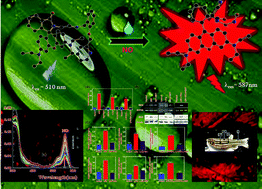A rhodamine-based turn-on nitric oxide sensor in aqueous medium with endogenous cell imaging: an unusual formation of nitrosohydroxylamine†
Abstract
A new sensor (L3) based on Rhodamine-B-en (2) and 2-(pyridin-2-ylmethoxy)benzaldehyde (1) has been developed for highly sensitive and selective recognition of NO in purely aqueous medium where the reaction of NO with the fluorophore leads to an unusual formation of nitrosohydroxylamine with the selective opening of the spirolactam ring over different cations, anions, amino-acids and other biological species with prominent enhancement in absorption and emission intensities. A large enhancement of fluorescence intensity for NO (11 fold) was observed upon addition of 3 equivalents of NO into the sensor in aqueous HEPES buffer (20 mM) at pH 7.20, μ = 0.05 M NaCl with naked eye detection. The corresponding Kf value was evaluated to be (7.55 ± 2.04) × 104 M−1 from the fluorescence titration plot. Quantum yields of L3 and the [L3 + NO] compound are found to be 0.07 and 0.77, respectively, using Rhodamine-6G as the standard. The LOD for NO was determined by the 3σ method and found to be 83.4 nM. The L3 sensor has low cytotoxicity, and is cell permeable and suitable for in vitro NO sensing. The in vivo compatibility of the sensor was also checked on zebrafish.



 Please wait while we load your content...
Please wait while we load your content...